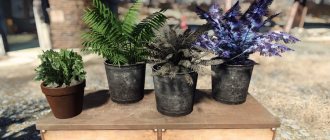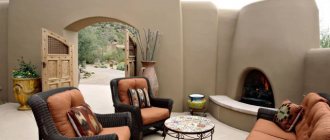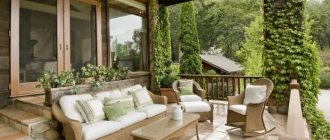Depending on the location and the chosen design, vertical gardening can not only serve as an element of interior decoration, but also hide existing shortcomings.
This method of revitalizing an interior has gained popularity among many due to its relative ease of production and a wide range of styles and options. Vertical landscape design is chosen independently, which allows you to use your own ideas for decorating the interior and exterior.
Vertical gardening on the balcony
Vertical gardening of a private house
Design ideas for vertical gardening in the interior of different rooms
There are many methods of vertical gardening; the appropriate one is selected based on the size and functionality of the room.
In the interior of the living room, a phytopannel or a picture in a wooden frame hangs above the sofa, the opposite wall is placed in front of the sofa or window. The mobile modular system is convenient for zoning, for example, separating the sleeping side from the corridor in a one-room apartment.
The room where good air is most needed is the bedroom. Choose plants for this room carefully: for example, monstera is famous for its nighttime oxygen consumption.
Free space for vertical gardening in the kitchen is in the dining area. But for many, the idea of using herbs in the cooking area will be relevant - it is not only beautiful, but also convenient.
In a damp area of the bathroom with a constantly high level of humidity (bathtub, shower), moss will take root well. Near the sink or toilet for vertical gardening in the apartment, use the moisture-loving scindapsus, spathiphyllum.
Caring for flowers can be a simple chore that will help teach your child how to do their chores. Both kids and adults will love colorful and vibrant succulents—they look elegant and require virtually no maintenance.
You can make a wall or panel of greenery yourself, but if you do not have experience in caring for flowers, it is better to entrust the selection and planting to professionals. Designers will do the basic work and advise further care to preserve the resulting beauty.
Types of vertical gardening structures
There are different types of vertical gardening, which have their own distinctive characteristics and are suitable for decorating specific spaces.
Phytomodules
There are 2 options for modules for vertical wall gardening:
- Mobile design with automatic watering system. Comes in different sizes and designs. Used as a dividing screen for zoning or placed against a wall.
- Wall panel with pockets for plants. It does not take up much space, suitable for placement on a sofa or bed.
Phytomodules can be either very simple, requiring regular maintenance, or autonomous: they are connected to an outlet, and water supply, irrigation and lighting are independently regulated.
Important! Carefully choose the material for containers - they are made of plastic, felt, metal, wood, sisal. Each option has its pros and cons. For example, felt does not rot, but perfectly absorbs moisture and releases it into the air. Plastic is not environmentally friendly; in the absence of drainage holes, this can lead to rotting of the roots.
The photo shows an example of phytomodules
Phytopanno
Floral paintings are often created from stabilized plants (mostly moss) or unpretentious species: succulents, ferns. They are small - convenient for decorating a wall above a desk, or large - for example, half the size of a sofa.
The advantage of phytopane is the almost complete absence of soil; therefore, pollution from it will be minimal, which is why this option for vertical gardening is often used in kitchens.
Carpet landscaping
Based on the scale of vertical gardening in the interior and creating an entire green wall, be prepared for additional costs in the form of automatic water supply, light control, and a humidity sensor.
It is automation that will help keep plants safe and sound, guaranteeing them the right conditions for a quality life.
Landscaping all or part of a wall is the best way to improve the air quality in your home and reap the other benefits of an indoor garden.
Device tips
It is recommended to place the vertical structure of a plant installation only near walls that do not bear a functional load. It must be strong enough to withstand the load of plants and soil. Plastic panels must be installed at the ends of the structure. They will prevent water spillage when watering.
To reduce the number of waterings of plants in a living wall, place a piece of rags next to them, which are periodically moistened with plenty of water.
What type of soil can be used in vertical gardening
The main types of vertical gardening are hydroponic and soil. In the first case, you will have to make a choice between the most unpretentious plants; in the second, the choice is a little wider, since your garden will receive all its nutrients from its natural and familiar environment.
Expanded clay and sphagnum moss most often act as hydroponics: moss retains moisture well, and expanded clay provides access to oxygen.
What plants are suitable for vertical gardening?
To choose the right plants, you need to understand what is required of them:
- The root system has been developed;
- Lack of stem, bushiness;
- Small size;
- Unpretentious;
- Climbing plants.
For clarity, you can consider several examples of the most unpretentious plants suitable for beginners. Each of these crops is unpretentious and will allow you to quickly plant trees in the required area:
Chlorophytum (chlorophytum) - any type of this plant will look great in a vertical composition. It is not only beautiful, but also useful for others, as it accumulates harmful substances and processes them. The dirtier the air in the apartment, the faster it will grow. It can be placed in individual pots in horizontal rows of the structure.
Chlorophytes and ferns.
Philodendron (philodendron) is a perennial evergreen plant that can grow quickly. This is a climbing plant, translated means “I love the tree.” It has many types. Does not require bright lighting, but loves humidity.
An example of a simple form that can be used in any room. Pileas, rhipsalis and philodendrons are used.
Hedera (ivy) is a climbing stem. It has many simple shaped leaves with three to seven lobes. They thrive in the shade, do not require watering and do not require constant attention. But sometimes it is necessary to water.
Green wall with ivy, syngonium and bromeliads.
Epipremnum (scindapsus) is a vine with beautiful large leaves. It is unpretentious, grows well, so it needs to be pinched. When used in a phytomodule, it retains its design well. At home it does not bloom, the root system is fibrous. Aerial roots form on the stems, which subsequently become rigid.
In this industrial form, among other crops for scindops, for example, the second vertical stripe from the left edge is used.
Asparagus (asparagus). Fast growing. It takes a lot of time. It belongs to the asparagus plant family. It has thin flexible stems, leafy shoots that resemble needles and serve as leaves. It seems airy and weightless. An unpretentious plant. Used in the design of vertical cascading compositions.
Green walls with asparagus.
Thyme (Tradescantia). Excellent for indoor breeding. Hangs beautifully in the form of rings. When pruned frequently, it takes the form of a small bush. It has bright and colorful leaves. Undemanding to living conditions.
For the kitchen, you can choose a composition of edible plants: onions, dill, parsley, mint. This approach will decorate the room and give the family fresh greenery.
Indeed, there are a lot of plants suitable for planting in a phytomodule; there are practically no restrictions. Unless very capricious plants with special requirements are suitable. So the choice of plant for a phytomodule depends on the preferences of the owner. In addition, the choice of plant species can be entrusted to a phytodesigner.
Design ideas
Plantogram
The living picture has the form of a plant canvas with small flowers. It occupies part of the living room wall. Succulent plants are used to create a plantogram. The main theme of the paintings is still lifes.
Big beats
Plants with large leaves are used to create a living wall. It is better to place such structures in niches. It creates a feeling of penetration of vegetation from the street and closeness to nature. Designs of this type always occupy a central place in the interiors of premises.
Japanese grace
A Japanese-style living wall is made in the recess of a window. The composition consists of several branches of vegetation of the same decorative type. They are used in interiors designed in a minimalist style. They create the feeling of greenery looking through the window and emphasize the laconic design of the room.
Green pockets
Ceramic pots, plastic or wooden containers are used in the design for planting plants. Each of them houses one or more plants. Modules with them are placed on the frame in a certain order, creating a composition.
Merging fragments
Modules with plants are placed on the wall in scattered fragments. In such a composition it is easy to update the panels and change the appearance of the wall.
Moss panels
Used for installation in bathrooms.
Live waves
The idea is suitable for decorating surfaces whose integrity is destroyed by door and window openings. Several types of plants have lines that create intricate patterns.
Inclined installations
Containers or pots with plants are installed in double-sided niches located at a slight angle. To create a living wall, only one variety of plants is used.
Green columns
They consist of climbing plants that are planted in pots and allowed to trail along a cone-shaped frame. The most common places to install green columns are: bathroom, kitchen, hall. This type of installation is best suited to Mediterranean-style interiors.
Useful accessories for vertical gardening
Simply stringing ropes from the ground to the roof to grow ornamental vines or vines is a thing of the past.
Simple stringing has given way to thoughtful, practical and more attractive use of plants
Plants are planted according to their properties: growth rate, splendor
Various vertical gardening designs are now being offered to create luxurious green walls in the garden. They are needed not only to care for plants, but also to complete the composition.
Vertical landscaping of the facade of a one-story house
Similar designs can be purchased in a store or made with your own hands:
- Arches have long been used to decorate open spaces. By placing several intertwining arches with climbing plants in a row on a garden path or resting place, you can create an island of romance in your garden.
Arch with white flowers covered with it
Arches in a row will create an excellent gallery of flowers
- A pergola is a tall wooden lattice, which can also be installed with any screws. A pergola can be part of a gazebo, bench, terrace, or used in conjunction with arched structures.
Gazebo in flowers
- Wire mesh or trellis is another affordable option for creating vertical landscapes. You can make a whole “green” pole from the mesh by twisting a cylinder, or decorate a flowering wall by placing it around the perimeter of a small barn or other outbuilding.
Metal mesh in the form of honeycombs
Living pillars are formed on metal gratings around the columns
- Flower stands are great for creating vertical flower beds. Usually these are cone-shaped structures on which you can place different flowerpots or vases with any flower. It’s easy to make such a stand with your own hands from scrap materials by placing several pots on a piece of driftwood or a metal pin.
A simple flower stand will help you place a few more vases
- Stairs with wide steps make excellent flower pots. For these purposes, you can use a ladder or something similar so that the structure is not leaned against the wall, but stored in any free space.
Using stairs in the garden and flower arrangement
- Hanging containers, boxes or other containers that can be mounted not only against walls, but also on tree branches look interesting, although you should not make the structure heavier. An original idea is to use old tires as flower containers that are hung in several rows.
Container with hanging wooden structure for vertical gardening
Metal flower pots
Vertical gardening with flower pots on stands
- The basis for a hedge when decorated with climbing plants will be a fence or screen.
Screens with vertical gardening
Fence with vertical landscaping
- The hut itself is an original decoration of the garden, and if you also plant flowers on its walls, then you can only envy the resting place for children and adults.
Several arches located nearby will be an excellent base for the theater.
- Curved water pipes attached to the wall with holes drilled in them make a great home for small, large plants.
Flower arrangement with water pipes
There are many more different vertical structures you can come up with, you just need to evaluate the available garden space and use your imagination.
Circles of bright green moss look great on bare concrete
Vertical composition of succulents in a metal frame
How to properly organize the lighting of a green wall
Despite the fairly successful experiments of Patrick Blank, a sufficient amount of light is required for the full growth and development of plants. And it’s better to be as close to natural as possible. However, in this case it is important not to overdo it.
Some plants don't really like direct sunlight. In this case, the green fence can be installed a little in the shade.
If for some reason the flow of natural light into the room is limited, then it needs to be organized.
Important! All plants require lighting at least 12 hours a day. To solve this problem, it is better to use LED lamps, they are cheaper.
In summer, lighting will most likely be sufficient, but in winter, even in a room with large windows, it will have to be arranged additionally.
FAQ
What temperature is required for normal growth of scindapsus?
Scindapsus grows quickly in room conditions at a moderate temperature of +15-18°C. Its leaves must be frequently sprayed with exclusively soft water.
What types of aglaonema are best to use to decorate a living vertical wall?
When creating a vertical living wall, it is better to use the following types: Red Diamond, Maria and Silver King.
Where is the best place to install a living wall with arrowroot?
Arrowroot improves a person's sleep, so it is better to install a wall made of it in the bedroom.
How to properly care for spathiphyllum growing in a living wall?
The plant must be protected from direct sunlight, sprayed frequently and fed once every 10 days.
Is it possible to use anthurium to create a living wall on a glazed loggia?
The plant can grow in rooms where the temperature does not drop to +15°C.
Watering in vertical gardening
Modern irrigation systems for constructing green walls are built into the frame. They are equipped with special containers for forced watering. In this way, you can organize both watering and fertilizing of plants.
In addition, residual moisture accumulates in the trays according to the same principle as defrosting a refrigerator. Excess moisture may re-enter the container.
In general, caring for green walls is similar to caring for ordinary indoor plants: abundant watering and fertilizing during flowering, moderate watering during the dormant period, removing dry leaves.
Important! Water for irrigation must first be stored in a jar or bottle.
Living Wall Care
All plants need moisture and light, as well as food, to live. The main thing in caring for them:
- Irrigation. It is difficult to ensure regular watering of dozens of pots by hand, so there is an automatic system for green walls. It consists of a water container, a mini pump and tubes for each flower. Regular watering is ensured by humidity sensors and timers.
- Fertilize the plants periodically, following the recommendations for each species.
- Adequate lighting is critical for growth. Near the structure on the ceiling or walls, it is necessary to strengthen phytolamps or LED lighting, which will not dry out the plants.
- A living wall should be sprayed regularly to provide fresh color and remove dust.
- From living greenery, you will need to regularly remove dry leaves, trim shoots, identify diseases and pests in order to take the necessary protective measures in time.
What is phytowall
The phytomodule and phytowall in the interior are a ready-to-use structure on a plastic or other durable base, with fresh flowers and decorative elements planted in special recesses.
At your discretion, the structure can be equipped with an automatic watering system, connection to an alarm system or a smart home panel. The parameters of such decor can vary from 0.5 to 5 m2, depending on the size of the home and the financial capabilities of the owners.
Ways to design “green” areas in the interior of an apartment
In an apartment, vertical gardening of walls is carried out according to slightly different rules due to the need for excellent waterproofing so as not to damage the walls or floor of the room. All landscape systems can be divided into two groups: land use or growing flowers in hydroponics (artificial environment).
Vertical decoration of gaps between windows
Advice! There are advantages in both one and the second option, so vertical gardening indoors should be chosen based on the initial data: availability of funds, ease of installation and choice of plants.
Vertical gardening of walls, made in special niches
Vertical gardening in an apartment can be created in several ways, using different plants:
The simplest option is narrow chrome or wooden shelves from floor to ceiling, on which boxes with wide or other beautifully flowering plants are located. If there is no space on the walls of the room, you can buy or make a floor stand for flowers, which will quickly become the center of the composition.
Vertical gardening hanger
Floor Vertical Garden Rack
A substitute for conventional shelving is a phytomodule for vertical gardening, the design of which can revitalize an entire wall. These are ordinary hanging boxes arranged in several rows, into which pots with slightly inclined plants are placed.
They are often bought for offices and restaurants, but you can make such furniture at home without spending a lot of money. When erecting a structure, you need to pay attention to the watering system: either you provide automation, or you do everything the old fashioned way, that is, the flowers are watered manually.
Vertical gardening in the office
Vertical gardening in the bathroom
Hanging planters have long been a popular method of vertical gardening, where climbing plants look good. Instead of hanging containers, you can attach several rows of nails to a wooden panel for small cups or teapots with flowers.
A panel of succulents, which can be placed in a shallow box directly in small pots, is perfect for decorating an apartment. The vases are glued to the bottom of the box, and the space between the vases is filled with some decorative material (canvas, straw, moss). In the same way, you can “paint” images by filling in a previously drawn outline with succulents.
Panel succulents
Picture of succulents in a table frame
The original wall decor will come from a moss pattern. The moss is mixed with water and a moisture-holding gel in a blender, then the mixture is applied with a brush to a wooden or concrete surface. It is important to choose the type of moss that will feel good on such a surface. For maintenance, you only need to spray this model once a week.
Vertical gardening with square modules with moss
In the kitchen you can decorate hanging fabric pockets with green seedlings. It is important to organize the sump so that when watering, water does not spill onto the floor. The seedlings are placed in prepared compost. The greens will fall onto the hosts’ table straight from the garden.”
Hanging tubs with various herbs
Pros and cons of vertical gardening
5 Benefits of Indoor Vertical Gardening:
- Improving the microclimate. Everyone knows that plants absorb carbon dioxide to produce oxygen. The vertical garden is no exception.
- Soundproofing. In addition to CO2, the living wall absorbs unnecessary noise, so the room will become noticeably quieter.
- Save space. Flowers on the wall are a great way to save space in a room while making it appear greener.
- Automatic control of temperature and air humidity. It is worth choosing the right number of climbing plants in order to forget about the air conditioner once and for all: in the heat, flowers release moisture, which leads to a decrease in the overall temperature in the room.
- Decorative. One cannot argue with the fact that vertical gardening in an apartment looks very impressive. The composition can replace another decoration or complete hanging paintings or watches.
Disadvantages of vertical gardening:
- Moisture accumulation. To avoid the appearance of fungus, just choose a warm, dry wall, protect it from the inside with film and adjust the watering.
- Destruction of the coating. Some types of screws cling directly to the walls, thereby compromising the integrity of the decorative coating. To prevent this from happening, the branches need to be directed along the grid or trimmed in time.
- Difficulty starting. Watering, feeding, and replanting the inhabitants of a phytowall is more difficult than ordinary potted plants.
In the photo there is a panel made of stabilized moss in the living room
Photos of beautiful ideas for vertical gardening of apartments and adjacent areas
We invite you to learn more about different vertical gardening methods in our gallery. Here you will find many photos of successful phytowall projects both in adjacent areas and in interiors. Good vision!
Where to arrange a garden
Vertical gardening is a piece of living nature that can be placed in almost any room, even in the bathroom. It can not only decorate the room, but also bring psychological pleasure, purify the air, and saturate it with oxygen. This decor is nice to look at. By observation, you can see how plants grow and develop, how they bear fruit, and how the process of withering occurs.
If you are not confident in your abilities, do not ignore the services of phyto-designers
Yes, there are special people who will help with measuring humidity and lighting parameters, selecting the necessary plants and actually organizing vertical gardening in the apartment. If you are not sure whether you can handle the task on your own, seek help from specialists. They will also advise you on caring for the selected plants.
There are also entire companies specializing in vertical gardening. If you are planning to organize, for example, a large phytowall (or even more than one), then it makes sense to contact only such a company. In addition, such companies often have after-sales services: specialists look after your vertical garden, and if one or more plants die or become ill, they will be replaced under warranty.
Flower planting technology
For vertical green decorations, any type of plant of medium and small size is suitable as a phytomodule. Planting flowers and installing the structure is quite simple, so you can cope with this task yourself.
You should begin work by placing small expanded clay in each cell. Sphagnum moss is used as the basis for planting flowers. You can buy it at almost any flower shop. The unique properties of such moss include good absorption, long-term moisture retention and bactericidal qualities that prevent the appearance of fungal diseases on plants.
The only disadvantage of such a phytomodule is its high cost. If your immediate plans do not include large financial expenses, but the idea of landscaping a room in a similar way seemed interesting to you, you can make a phytowall with your own hands.











